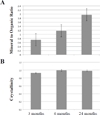Connective tissue mineralization in Abcc6-/- mice, a model for pseudoxanthoma elasticum
- PMID: 22421595
- PMCID: PMC3340454
- DOI: 10.1016/j.matbio.2012.02.004
Connective tissue mineralization in Abcc6-/- mice, a model for pseudoxanthoma elasticum
Abstract
Pseudoxanthoma elasticum (PXE) is a heritable multisystem disorder characterized by ectopic mineralization. However, the structure of the mineral deposits, their interactions with the connective tissue matrix, and the details of the progressive maturation of the mineral crystals are currently unknown. In this study, we examined the mineralization processes in Abcc6(-/-) mice, a model system for PXE, by energy dispersive X-ray and Fourier transform infrared imaging spectroscopy (FT-IRIS). The results indicated that the principal components of the mineral deposits were calcium and phosphate which co-localized within the histologically demonstrable lesions determined by topographic mapping. The Ca/P ratio increased in samples with progressive mineralization reaching the value comparable to that in endochondral bone. A progressive increase in mineralization was also reflected by increased mineral-to-matrix ratio determined by FT-IRIS. Determination of the mineral phases by FT-IRIS suggested progressive maturation of the mineral deposits from amorphous calcium phosphate to hydroxyapatite. These results provide critical information of the mechanisms of mineralization in PXE, with potential pharmacologic implications.
Copyright © 2012 International Society of Matrix Biology. Published by Elsevier B.V. All rights reserved.
Figures





References
-
- Anderson HC, Reynolds JJ. Pyrophosphate stimulation of calcium uptake into cultured embryonic bones. Fine structure of matrix vesicles and their role in calcification. Dev. Biol. 1973;34:211–227. - PubMed
-
- Camacho NP, Carroll P, Raggio CL. Fourier transform infrared imaging spectroscopy (FT-IRIS) of mineralization in bisphosphonate-treated oim/oim mice. Calcif. Tissue Int. 2003;72:604–609. - PubMed
-
- Chua-Anusorn W, Webb J. Infrared spectroscopic studies of nanoscale iron oxide deposits isolated from human thalassemic tissues. J. Inorg. Biochem. 2000;79:303–309. - PubMed
Publication types
MeSH terms
Substances
Grants and funding
LinkOut - more resources
Full Text Sources
Molecular Biology Databases
Miscellaneous

